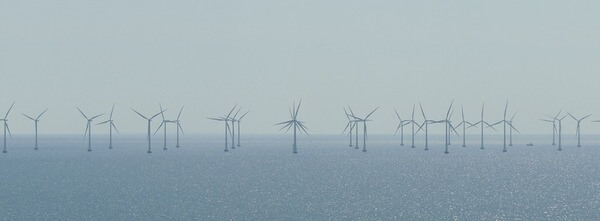News Release from Global Wind Energy Council
Wind Industry Profile of
China installed half of new global offshore wind capacity during 2020 in record year
According to the latest data released by GWEC Market Intelligence, the global offshore wind industry had its second-best year ever in 2020 installing over 6 GW of new capacity, keeping growth on track despite the impacts of COVID-19 felt in other energy sectors. This growth was driven by a record year in China, which lead the world in new annual offshore wind capacity for the third year in a row, and installed over half of the new offshore wind capacity globally last year.
Steady growth in Europe accounted for the majority of remaining new capacity, led by the Netherlands which installed nearly 1.5 GW of new offshore wind in 2020, making it the second-largest market for new capacity in 2020 after China.
Other European offshore wind markets also experienced stable growth last year, with Belgium (706 MW), the UK (483 MW), and Germany (237 MW), all installing new capacity in 2020. The slowdown of growth in the UK is due to the gap between the Contracts for Difference (CfD) 1 and CfD 2. In Germany, the slowdown is primarily caused by unfavourable conditions and a weak short-term offshore wind project pipeline.
The only new floating offshore wind capacity recorded in 2020 was also in Europe, with 17 MW installed in Portugal.
Outside of China and Europe, two other countries recorded new offshore wind capacity in 2020: South Korea (60 MW) and the US (12 MW).
Overall, global offshore wind capacity now exceeds 35 GW – a 106 per cent increase over the past 5 years alone. China has now surpassed Germany in terms of cumulative installations, becoming the second-largest offshore wind globally with the UK remaining in the top spot.
Feng Zhao, Head of Market Intelligence and Strategy at GWEC commented: “The continued growth of the offshore wind industry globally throughout the pandemic is a testament to the resilience of this booming industry. Although China was hit first by the COVID-19 crisis, the impacts on the offshore wind sector were minimal, resuming ‘busines-as-usual’ as early as March 2020. China’s record-breaking growth is expected to continue in 2021, driven by an offshore wind installation rush to meet China’s Feed-in-Tariff deadline by the end of this year”.
“While Europe remains the largest offshore wind market globally, Asia Pacific will play an increasingly important role driving industry growth as major economies such as Japan and South Korea have recently established ambitious offshore wind targets. The US will also become an increasingly important market for offshore wind, as the new administration has made it clear they are working to accelerate growth of this crucial industry”, he added.
The continued growth of the offshore wind industry globally throughout the pandemic is a testament to the resilience of this booming industry. Although China was hit first by the COVID-19 crisis, the impacts on the offshore wind sector were minimal, resuming ‘busines-as-usual’ as early as March 2020. China’s record-breaking growth is expected to continue in 2021, driven by an offshore wind installation rush to meet China’s Feed-in-Tariff deadline by the end of this year
Alastair Dutton, Chair of Global Offshore Wind Task Force at GWEC added: “Offshore wind is increasingly cementing its role as one of the most crucial technologies to decarbonise our energy system and achieve net zero. Current global offshore wind capacity has helped our society avoid 62.5 million tonnes of carbon emissions – equivalent to taking over 20 million cars off the road. The socioeconomic benefits of offshore wind are also more important than ever as countries develop their strategies for a green economic recovery, with current offshore wind capacity already providing around 700,000 jobs globally over the projects’ lifetimes”.

Image: Pixabay
“Yet, we are only seeing the tip of the iceberg when it comes to offshore wind’s massive potential. The World Bank Group reports that there is over 71,000 GW of offshore wind potential globally with current technology, and tapping into this resource will be key to keep global warming below 1.5°C pre-industrial levels, while generating significant economic benefits. To realise this potential, industry and government collaboration will be key, along with stable policies to provide a long-term horizon for industry growth. Accelerating the commercialisation of floating offshore wind this decade will also be crucial to open new doors for the sector, and capture more wind resource than ever thought possible”, he added.
Offshore wind is increasingly cementing its role as one of the most crucial technologies to decarbonise our energy system and achieve net zero. Current global offshore wind capacity has helped our society avoid 62.5 million tonnes of carbon emissions – equivalent to taking over 20 million cars off the road. The socioeconomic benefits of offshore wind are also more important than ever as countries develop their strategies for a green economic recovery, with current offshore wind capacity already providing around 700,000 jobs globally over the projects’ lifetimes
New Offshore Wind Capacity in 2020
- PR China – 3,060 MW
- Netherlands – 1,493 MW
- Belgium – 703 MW
- UK – 483 MW
- Germany – 237 MW
- South Korea – 60 MW
- Portugal – 17 MW (floating)
- US – 12 MW
Top 5 Offshore Wind Markets for Cumulative Capacity
- UK – 10,206 MW
- China – 9,898 MW
- Germany – 7,730 MW
- The Netherlands – 2,611 MW
- Belgium – 2,259 MW
- Source:
- GWEC
- Author:
- Press Office
- Link:
- gwec.net/...
- Keywords:
- GWEC, offshore, capacity, wind power, 2020, China, floating, GW, jobs, global, Asia, GWEC Market Intelligence, Europe, USA, South Koreea



























